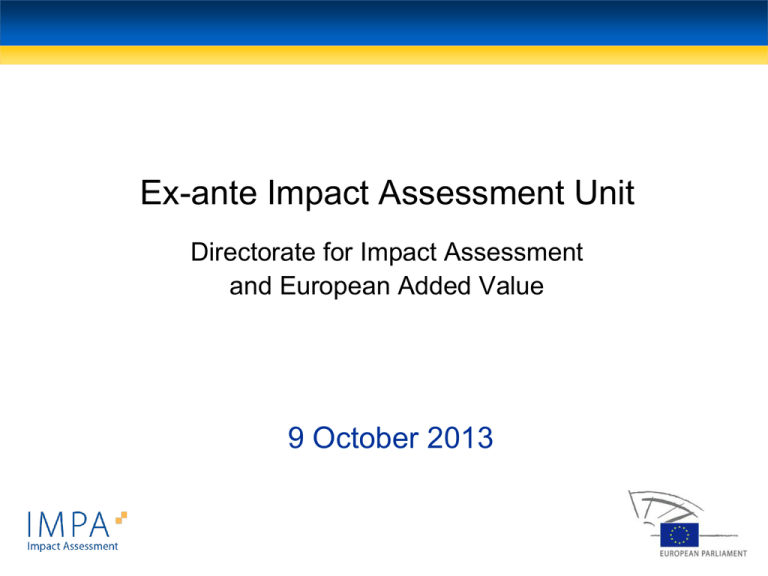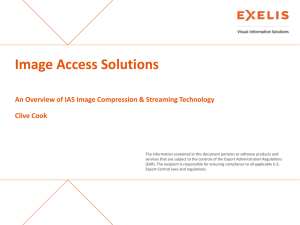EP_presentation_CoR workshop Oct 2013
advertisement

Ex-ante Impact Assessment Unit Directorate for Impact Assessment and European Added Value 9 October 2013 The Directorate for Impact Assessment and European Added Value • Lisbon Treaty (2009): European Parliament becomes co-legislator with the Council • Greater scrutiny of implementation of EU Law • EP committment to Better Law-Making in the EU: interest in ex-ante and ex-post scrutiny • Creation of new Directorate for Impact Assessment and European Added Value in 2012 Creation of the Impact Assessment Unit (IMPA) The Impact Assessment (IA) unit was established in early 2012 as part of the EP’s new Directorate for Impact Assessment and European Added Value. Chronology: • EP resolution of 8 June 2011 on guaranteeing independent impact assessments (Niebler report) calls for the “creation of an autonomous impact assessment structure for the European Parliament”. • Decision of the Bureau of 4 July 2011 to create a Directorate for Impact Assessment. What does IMPA do? It helps committees scrutinise the quality, completeness and independence of Commission Impact Assessments. How? Through an entirely new service: Initial appraisals of European Commission IAs • Systematic analysis of all incoming IAs • Identification of their strengths and weaknesses • 4-8 pages • Around 45 produced to date • Committees can decide course of action Other services provided by IMPA On the basis of these ‘initial appraisals’, committees can: – take up certain issues with the Commission; – ask IMPA to undertake further work, in the form of Detailed appraisals of Commission IAs Example: the Legal Affairs Committee recently asked for a Detailed appraisal of the proposed Common European Sales Law; – ask for Substitute or Complementary IAs Example: the Environment Committee has recently requested a Subsitute impact assessment on a directive relating to honey. Committees may also request IAs on the amendments they propose. These are commissioned by IMPA from external experts. Example: Recent assessment of the potential impact on SMEs of 18 EP amendments to two proposed Public Procurement directives. Summary of services provided by IMPA • Initial appraisals of European Commission Impact Assessments • Detailed appraisals of Commission IAs • Substitute or complementary IAs • Impact assessments on substantive EP amendments With the exception of initial appraisals, which are produced systematically, any other work from the Impact Assessment Unit requires a formal request from the Committee responsible on the basis of a decision by its coordinators. Quality criteria for Impact Assessments EP criteria to measure the quality of Impact Assessments: • Transparent and targeted public consultations involving regional and local authorities; • Proper justification of selected options (principles of subsidiarity and proportionality); • Balanced analysis of economic, social and environmental impacts; Impact on: budgetary and MFF obligations, administrative burdens, competitiveness, SMEs (SME test), internal market freedoms (internal market test), vulnerable social groups (social benchmarking) and third countries. The territorial dimension Examples of IAs treated by IMPA where the regional or territorial dimension was important: • • • EC proposal on Manufacture, presentation and sale of tobacco and related products: “The Commission could have been more explicit about regional consequences, by considering territorial impacts regarding tobacco production and manufacturing”; EC Fourth railway package proposal: “Notes on indirect economic impacts cover the aspects of innovation, macro-economic growth, regional impacts, relations with third countries and SMEs outside rail, but the results are not included in the comparative table of economic impacts”; EC proposal on Deep-sea stocks which has an impact on a limited number of countries and regions active in deep-sea fishing; One of the recurring criticisms in initial appraisals is that the IAs often do not identify precisely which Member States and regions will be the most affected by different policy options. Inclusion of the regional dimension Few Commission Impact Assessments up to now include an explicit assessment of the territorial dimension of proposals, often because of lack of data. This could change due to: • Publication by the Commission of territorial impact assessment guidelines (2013) giving important guidance on relevant modelling and methodological techniques; • Progress made in data collection through programmes such as ESPON. IMPA will continue to scrutinise the Commission’s IAs bearing in mind the territorial and regional dimensions. European Added Value In parallel to IMPA, we have a European Added Value Unit (EAVA) that helps Parliament identify areas where common European action or better coordination of existing national and European policies would be costeffective or would help realise collective ‘public goods’. EAVA services European Added Value Assessments Cost of Non-Europe reports Added value of existing EU policies European Added Value services • Parliament has the right to propose legislative initiatives to the Commission: these are now accompanied by a European Added Value Assessment, which presents the best possible arguments for the initiative in question. • EAVA also produces Cost of Non-Europe reports (CoNE)on policy areas where stronger EU-level action could be beneficial. • Today, too many of our citizens have forgotten or do not see the positive benefits of existing EU action. In many areas, Europe is seen just as an added cost. EAVA not only researches the potential benefit of future action, but also the added value of current policies on the ground. Conclusion IMPA and EAVA work is important both now and as we prepare for the European elections of 2014: • MEPs want to be able to show that the EU can make and is making - a positive difference for the citizen. • When the new Commission comes into office in 2014, the Parliament will be in a much stronger position to justify its policy initiatives, as a lot of the advance research and analysis will already have been done. • Impact Assessment work contributes to improved output from Commission DGs and European Added Value work strengthens the Parliament’s case when using its right of initiative. Developments • New Ex-post Impact Assessment Unit • Revision of EP handbook on impact assessment • New Parliament in 2014










